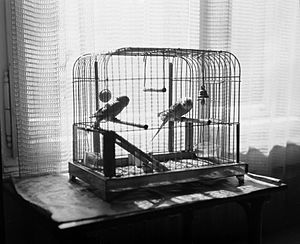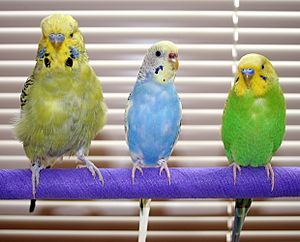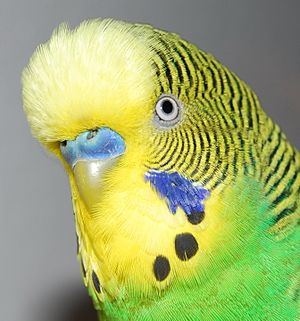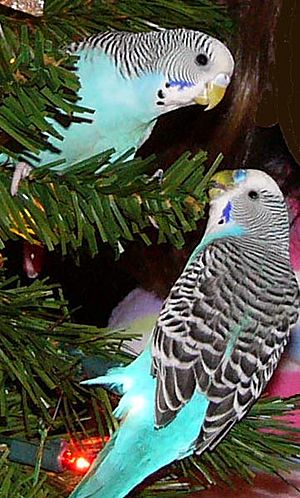Budgerigar facts for kids
Quick facts for kids Budgerigar |
|
|---|---|
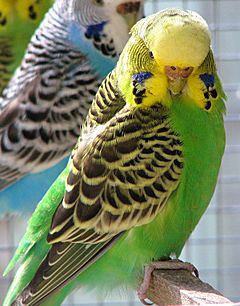 |
|
| Female Budgerigar of natural coloration | |
| Conservation status | |
| Scientific classification | |
| Kingdom: | |
| Phylum: | |
| Class: | |
| Order: | |
| Family: | |
| Subfamily: | |
| Tribe: |
Platycercini
|
| Genus: |
Melopsittacus
Gould, 1840
|
| Species: |
M. undulatus
|
| Binomial name | |
| Melopsittacus undulatus |
|
The Budgerigar (often called a budgie) is a small parrot. It belongs to a group of parrots known for their wide, flat tails. In American English, budgerigars are often called parakeets. The word "parakeet" actually describes many types of small parrots with long tails.
Budgerigars come from the dry parts of Australia. They have lived there for over 5 million years! Many people keep budgies as pets because they are smart birds. Some can even learn to copy human speech.
All About Budgerigars
Budgie Bodies: Anatomy and Features
Wild budgerigars are about 18 centimeters (7 inches) long. They weigh about 30 to 40 grams (1 to 1.4 ounces). Their wingspan is around 30 centimeters (12 inches). Wild budgies are usually light green on their bellies and backsides. Their backs and wing feathers have black markings that look like waves, outlined in bright yellow.
Adult budgies have yellow faces and foreheads. Young budgies have black stripes down to their nose area (called the cere). These stripes disappear when they get their adult feathers at about three or four months old. Budgies also have small, shiny blue-violet patches on their cheeks. They have three black spots on each side of their throats. Their tails are dark blue, with yellow flashes on the outer tail feathers. Their wings have greenish-black flight feathers and black feathers with yellow edges. You can see these yellow flashes when they fly or stretch their wings. Their beaks are olive grey, and their legs are bluish-grey. They have special toes that help them grip branches.
Budgerigars in Australia are smaller than those kept as pets. Pet budgies have been bred in many different colors. You can find them in blue, grey, grey-green, and even white or yellow. Like most parrots, budgie feathers glow under ultraviolet (UV) light. This glow might help them choose a mate.
The top part of a budgie's beak is much bigger than the bottom part. It covers the bottom part when closed. Their beaks are perfect for eating plants, fruits, and vegetables.
Telling Boys from Girls: Cere Colors
The color of a budgie's cere (the area around the nostrils) helps tell if it's a boy or a girl.
- Males: Usually have a royal blue cere.
- Females: Their cere can be pale brown to white when not breeding. It turns brown and sometimes crusty when they are ready to lay eggs.
- Young Budgies: Both sexes have a pink cere when they are young. Young females might have a chalky white color around their nostrils.
Some male budgies with special color types, like Albino or Recessive Pied, keep their purplish-pink cere their whole lives. It's usually easy to tell a budgie's sex after six months old by their cere color. Their behavior and head shape can also give clues.
- Adult Males: Their cere is usually light to dark blue. Some special color types might have purplish-pink ceres. Males are often cheerful, friendly, and very talkative. They usually have rounder heads.
- Adult Females: Their cere starts pink when young. It becomes beige or whitish when not breeding, and brown and crusty when breeding. Females often have flatter heads. They are typically more bossy and less tolerant of other females.
How Budgies See the World
Like many birds, budgerigars have tetrachromatic color vision. This means they can see four basic colors, including ultraviolet light. They need full sunlight to use all their color vision. The UV light makes their feathers look brighter, which helps them attract mates. The throat spots on budgies also reflect UV light. This helps them tell individual birds apart.
Where Budgies Live: Their Environment
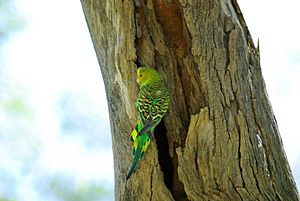
Budgerigars are nomadic birds. This means they move around a lot. They live in open areas of Australia, like scrublands, open woodlands, and grasslands. They usually live in small groups, but can form very large flocks when there's plenty of food and water.
Their travels depend on where they can find food and water. If there's a drought, they might move to areas with more trees or closer to the coast. They mostly eat seeds from spinifex and other grasses. Sometimes, they eat ripening wheat.
Some wild budgerigars have been seen in St. Petersburg, Florida, in the United States since the 1940s. However, they are much less common there now. This is probably because of competition from other birds like European starlings and house sparrows.
Budgies and People
The Name "Budgerigar"
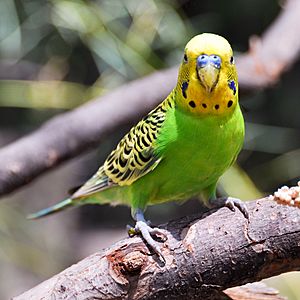
The name "budgerigar" has a few possible origins:
- It might come from a mispronunciation of an Aboriginal word, gidjirrigaa. This could have been influenced by an old Australian slang word "budgery," which meant "good."
- Another idea is that it comes from gijirragaa from the Yuwaalaraay language.
- It could also be a mix of "budgery" (meaning "good") and gar (meaning "cockatoo").
The budgerigar was first described by George Shaw in 1805. Its scientific name, Melopsittacus undulatus, was given by John Gould in 1840. The genus name Melopsittacus comes from Greek and means "melodious parrot." The species name undulatus is Latin for "undulated" or "wave-patterned," referring to their feather patterns.
Other common names for the budgerigar include the shell parrot, the warbling grass parakeet, and the zebra parrot. Sometimes, they are even called lovebirds because they like to preen (clean) each other's feathers.
Budgies as Pets: Aviculture
People have been breeding budgerigars in captivity since the 1850s. Breeders have created many different colors and patterns. Some of these include albino (all white), blue, clearwinged, crested, and violet.
"English budgerigars" are also called "show" or "exhibition budgerigars." They are about twice as big as wild budgies. They have larger, fluffier head feathers that can almost hide their eyes and beak. English budgies are usually more expensive and live for about seven to nine years. Most pet budgies you see in stores are similar in size to wild budgies.
Budgerigars are social animals. They need toys and interaction with humans or other budgies to stay happy. Budgies, especially females, love to chew on things like wood. If a budgie feels scared, it will try to perch as high as possible. It will also pull its feathers close to its body to look thinner.
Tame budgies can be taught to speak, whistle, and do simple tricks. Both male and female budgies sing and can learn sounds and words. However, males are usually better at singing and copying words. Females rarely learn more than a dozen words. Males can easily learn a few dozen to a hundred words. Pet males, especially those kept alone, are often the best talkers.
Budgies will chew on anything they can find to keep their beaks trimmed. Mineral blocks (with iodine), cuttlebone, and soft wooden toys are good for this. Cuttlebones also provide calcium, which is important for strong bones and egg formation. In captivity, budgies usually live for five to eight years. Some have lived for 15 to 20 years! How long they live depends on their breed, family history, and health. Exercise and a good diet are very important.
Budgie Life Cycle: Breeding
In the wild, budgies usually breed between June and September in northern Australia. In the south, they breed from August to January. However, budgies are "opportunistic breeders." This means they will breed whenever it rains and there are lots of grass seeds. They show affection by preening or feeding each other. Budgies feed each other by eating seeds and then bringing them back up into their flockmate's mouth.
Budgies make their nests in holes in trees, fence posts, or logs on the ground. Females lay four to six eggs. The eggs hatch in 18 to 21 days. The young budgies leave the nest about 30 days after hatching.
In captivity, budgies breed best when given a nest box. The eggs are usually one to two centimeters long and pearl white if they are fertile. Female budgies can lay eggs even without a male, but these eggs won't hatch. A female's cere (nose area) turns a crusty brown when she is laying eggs. She usually lays between four and eight eggs, one every other day. She starts sitting on the eggs after laying her second or third. She will incubate them for about 21 days each.
Once she starts incubating, the female rarely leaves the nest. Her mate usually feeds her at the nest's entrance. Females usually don't let the male inside the nest unless he forces his way in. The age difference between the first and last chick can be 9 to 16 days. Sometimes, parents might eat their own eggs if they feel unsafe in the nest box.
Chick Health and Development
Sometimes, there are problems with breeding. Some chicks might die from diseases or attacks from other adult budgies. Females might fight over nest boxes. Sometimes, male budgies aren't interested in breeding. Keeping several pairs together in a flock can encourage breeding. Another problem can be "underlapped" beaks, where the lower part of the beak is above the upper part.
Most health problems in budgies are genetic. It's important to use active, healthy, and unrelated birds for breeding. Birds with fatty tumors or other genetic issues should not breed. Parasites (like lice or mites) and germs (like bacteria or viruses) can spread between birds. Nest boxes should be cleaned regularly.
"Splay leg" is a common problem in baby budgies. One of the chick's legs bends outward, making it hard to stand. This can happen if the nest box floor is too slippery. You can prevent this by putting a small amount of safe bedding or wood shavings in the nest box.
Eggs hatch in about 18 to 20 days. Baby budgies are born altricial – they are blind, naked, and can't lift their heads. Their mother feeds them and keeps them warm. Around 10 days old, their eyes open, and they start to grow soft feather down. This is when they can be banded with a closed leg ring.
They grow their main feathers around three weeks old. At this point, you can often see what color mutation the bird will be. The male usually starts entering the nest to help feed the chicks. However, some female budgies don't let the male in and raise the chicks by themselves until they leave the nest.
As the chicks grow feathers, they can be left alone for longer. By the fifth week, they are strong enough for both parents to spend more time outside the nest. The young birds will stretch their wings to get strong before they try to fly. They will also help defend the nest with loud screeches. Young budgies usually leave the nest around five weeks old. They are fully weaned (eating on their own) between six and eight weeks old. The oldest chick is usually weaned first. Hand-fed budgies might take a little longer to wean.
Budgie Colors: Mutations
All pet budgerigars come in two main color groups: white-based (like blue, grey, and white) and yellow-based (like green, grey-green, and yellow). There are at least 32 main color changes (mutations). These can be combined to create hundreds of different colors and patterns!
Budgies That Talk: Mimicry
Male budgerigars are known as some of the best talking parrots. They are often compared to the African grey, amazon, eclectus parrots, and ring-necked parakeet.
A male budgerigar named Puck, owned by Camille Jordan, holds the world record for the largest vocabulary of any bird. He knew 1,728 words! Puck passed away in 1994, and his record was first listed in the 1995 Guinness World Records.
In 2001, recordings of a budgerigar named Victor gained media attention. His owner, Ryan B. Reynolds, claimed Victor could have conversations and even predict the future. While some believed Victor could predict his own death, it's hard to study this without the bird. Critics say Victor's speech in the recordings isn't clear enough to be considered a real conversation.
Pet budgies continue to make news around the world for their talking skills and charm. One budgie, named Disco, became an internet star. By 2013, his YouTube videos had been watched over 6 million times! Some of Disco's famous phrases include, "I am not a crook" and "Nobody puts baby bird in a corner!"
Images for kids
See also
 In Spanish: Periquito australiano para niños
In Spanish: Periquito australiano para niños




